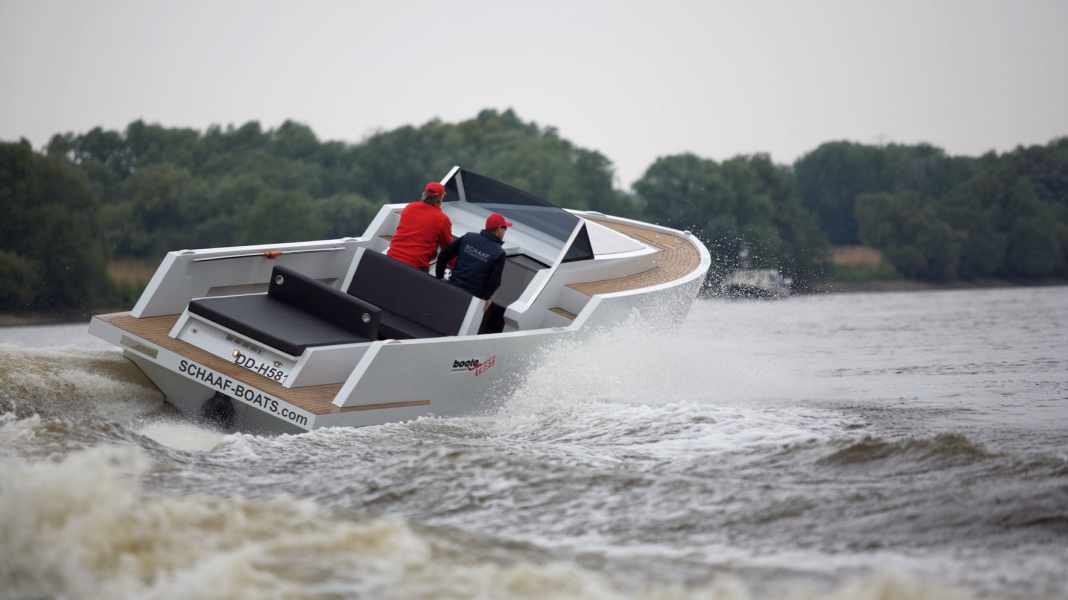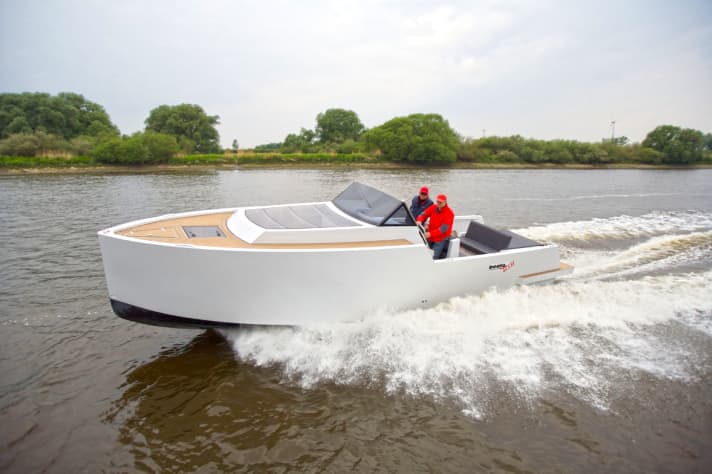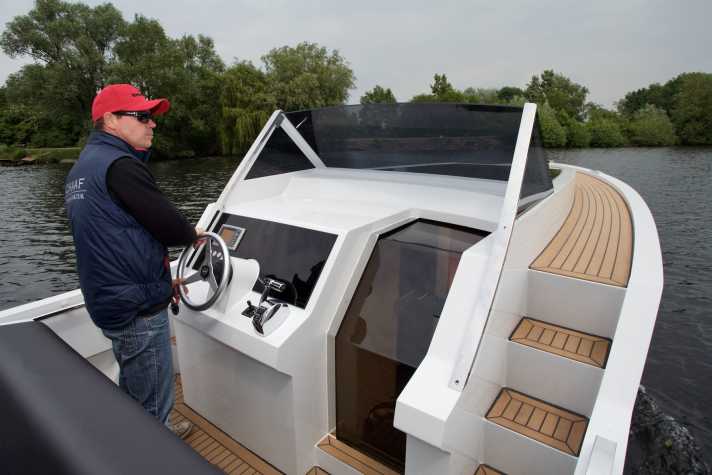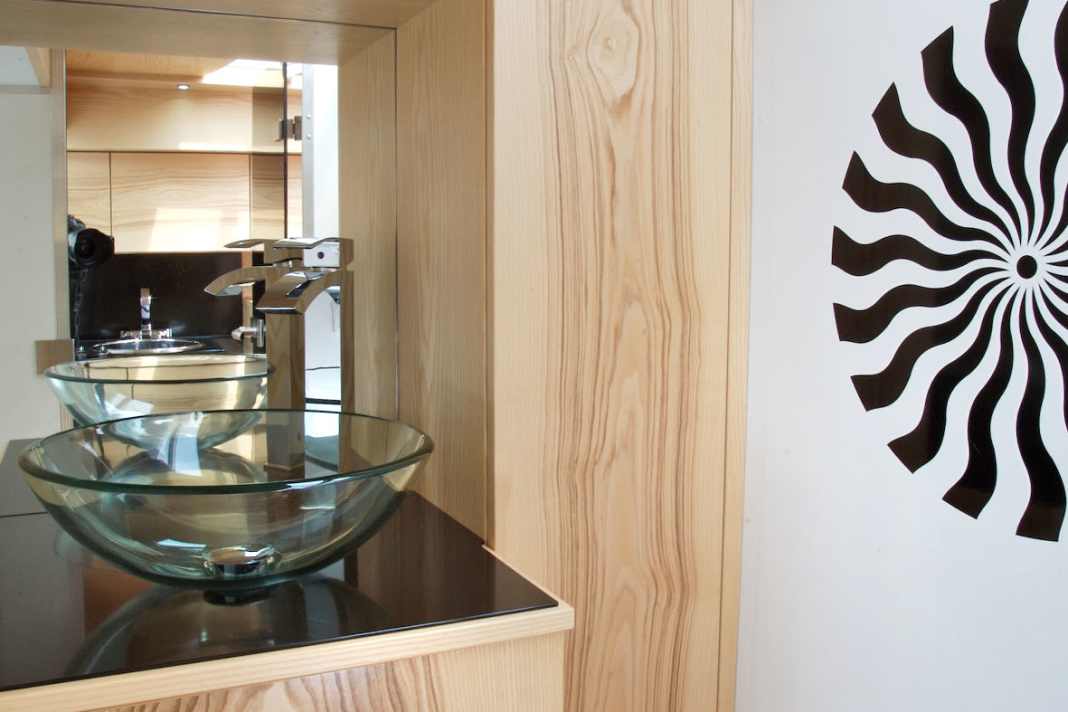

Building normal boats is not the vocation of Jörg Schaaf, Managing Director of the shipyard of the same name. "We are passionate about what we do," he says. And indeed, what you get to see with the Tender 31 is nothing ordinary. A backdecker with a straight design and futuristic appearance.

The boat is designed for areas outside coastal waters (CE category B). It is less of a cabin cruiser for longer holiday trips and more of a boat for pleasant excursions, where you can spend a night or two on board at the weekend.






Another special feature: the boat can still be transported with a 3.5 t trailer, which is rather rare for a 9.50 m length. This is made possible by the width limit of 2.55 m and a weight of just 2800 kg. The construction material is responsible for the latter. The shipyard boss has the Tender 31 manufactured from aluminium in the Netherlands. The result is a well-finished and painted hull. For the most part, the designers carried out the interior fittings to match. What we didn't like on the test boat were some gaps and silicone seams as well as crooked Flexiteak seams on the deck covering.
The shipyard recommends single and twin engines. We travelled with a MerCruiser 377 MAG. The V-8 petrol engine delivers its 320 hp to the water via a Z-drive with twin propellers. The maximum full-load speed of 5000 rpm, which is exactly in the centre of the recommended full-load range, shows that everything is well coordinated.
We reach a speed of just under 34 knots. It is no secret that a petrol engine is not particularly economical in this situation: 92 l/h or in other words 2.73 l/sm, which with the 400-litre tank minus reserve gives a range of 125 nm. Our test team is cruising economically at 3500 rpm (21.4 knots) with a fuel consumption of a good 2.00 l/sm - this results in a suitable range of almost 170 nm.
Anyone expecting the typical bow lift and lowering during the acceleration phase from displacement to planing speed will be disappointed. Although the nose rises, it hardly lowers at all. In terms of foresight, this means that the bow is sometimes disturbing when seated, but visibility is good when standing. Good, stable gliding starts at around 3000 rpm; the Z-drive is trimmed by feel. The stern wave is quite powerful at first, and becomes more "water-ski friendly" as the speed increases.
In cruise trim, the propeller pulls a little air in tight bends, but the twin propeller remains sufficiently force-fit that you don't have to restart. Trim down: Without any air snapping, you can turn round with a decent bank angle. The steering can be turned smoothly enough. On slalom courses and when the steering is jerked, the boat swings or lies heavily on its side. This behaviour can be explained by the shape of the hull and its length-to-width ratio. The latter is in the tender's powerboat range. In rough water - in this case the choppy water of Hamburg harbour - the hull cuts through the waves softly and dryly and is also quiet and stable on course.
If you are travelling at a slow speed and in calm water at 4 kn to 6.5 kn, you have to compensate for the course from time to time. The wind (a good 3 Beaufort) then makes itself felt, as the high bow provides a large surface to attack. The driver feels the same when he wants to dock and the wind comes directly from the side. In this situation, the bow thruster is an important aid.
Without wind, the Tender 31 turns at a good 2 boat lengths and when engaged in reverse at around 1 1/2 and takes around 5 seconds to reverse before the bow swings round. Too much throttle in reverse causes wet feet: from around 1900 rpm, water spills onto the gears to the left and right of the sunbed.
The driver is seated on an offshore bench with a short seat (can be folded up). The latter has firm cushions, while the backrest is soft. The bench offers no lateral support and the knee room is limited. It is better to ride standing up with the seat folded up. The front passenger sits on the same bench and has more legroom due to the cab entrance in front of him. A handrail in front of the passenger provides support, but it is angular, which cuts into the hands over long periods of time.
The car pool is protected by a plastic pane (Makrolon), which sits in aluminium profiles on the outside. The windscreen has a dark tint and the driving position a light colour. The disadvantage of this combination is reflections in the windscreen. If you want a windscreen wiper, you have to pay extra and get one with an automatic washer system, which first rinses sand and salt from the windscreen before wiping so that the wiper does not scratch it.
Electrical consumers are switched using well-positioned and illuminated pushbuttons. The shipyard has installed a SmartCraft Vessel View instrument that is easy to read and provides information on the engine status, fuel tank, consumption, range, speed, depth, course and position. The SmartCraft system also includes a gearstick that is very easy and precise to operate.
Engine, tank, electrics
The engine is accessed at the touch of a button via an electric drive that raises the rear sun lounger. Impractical: the main switch is located in the engine compartment. To switch it on, you have to lift the sun loungers by hand, reach through and turn the main switch. To keep the engine noise in check, the boat manufacturer glues the walls and cover with self-extinguishing sound insulation. It fulfils its task passably well up to 4000 rpm. At full throttle, the 85 dB/A limit is exceeded by 3 dB/A.
Two openings, which are covered with grilles, ensure sufficient fresh air. Service work can be carried out properly on the engine, which stands on a solid aluminium foundation. The technicians laid the cables and hoses in the engine compartment neatly, from aft to the control stand they run in protective pipes (integrated in the hull), but more care is required under the control stand.
What could be more obvious than making a tank from the same material for an aluminium boat? It sits firmly welded under the cockpit floor. The shipyard screwed its hose lines to the filler line with two clamps, but only with one screw clamp on the supply line to the engine. The petrol is cleaned by a fuel filter directly on the engine. The power supply is provided by two good-sized 110 Ah batteries in very solid plastic boxes. A diode distributor separates the two batteries from each other. Easily accessible circuit breakers and fuses protect the electrical system from overloading.
Security
The first thing every family man notices here is the missing railing/board wall at the rear. Such an open solution is particularly dangerous for children. The same criticism applies to the foredeck. There is no support of any kind here as standard. Lines can be taken and secured from the escape hatch. The same applies to the anchor. If you want to make the foredeck safer, a bow railing is available for 2856 euros; non-slip flooring on the entire deck area guarantees a firm footing. Further plus points: A bilge system with two electric and one manual pump as well as a fire extinguishing system in the engine compartment plus fire extinguisher. A standard three-step bathing ladder, which can be easily operated from the water, makes it easier to climb into the cockpit.
Living, cockpit and equipment
In the cockpit there are two double benches facing each other and a well-padded sun lounger. Additional sun cushions are available for the bow area. The only storage space on deck is under the driver's bench. If you go below deck, you will be surprised: the seating/sleeping area (with table), galley and wet room have a modern, cheeky design that is rarely seen on boats. The bright light through the plastic panoramic windows is inviting and friendly. The designer had to compromise on the (low) headroom.
Another special design feature: the six retractable, solid cleats. The fenders are attached to special leather holders on handrails that run along the inside of the side wall. A rubbing strake is missing; this can be fitted by the boat manufacturer from Dresden on request.
Data sheet: Tender 31
Shipyard: Schaaf boat manufacture
Type designation: Tender 31
CE category: B - Outside coastal waters
Material of hull and deck: Aluminium
Length: 9,50 m
Width: 2,55 m
Displacement: 2,80 t
Price: 215.033,00 €

